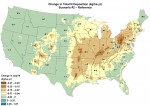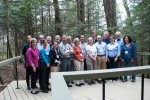Mapping New EPA Carbon Regs
On June 2, the U.S. Environmental Protection Agency (EPA) released the nation’s first-ever carbon pollution standards for existing power plants. The week prior, the Science Policy Exchange (SPE) -- a collaborative founded by four LTER sites -- released a new report to analyze how and where that EPA rule will improve local air quality, decrease atmospheric deposition, and benefit people and ecosystems across the U.S.
The report authors – from Syracuse University, the Harvard School of Public Health, and Harvard Forest Long Term Ecological Research (LTER) program– used three policy options for the EPA rule as a guide to model changes in power plant emissions over the next six years.
The study also quantified the resulting improvements in air quality. Detailed maps illustrate the benefits of decreased emissions from roughly 2,400 power plants in the continental U.S., analyzing the country 12 km x12 km at a time. The maps show that the greatest air quality benefits will occur in the eastern U.S., particularly in states in and around the Ohio River Valley, as well as the Rocky Mountain region.
- Download the report: Co-benefits of Carbon Standards: Air Pollution Changes under Different 111d Options for Existing Power Plants.
- Browse stories in the Harvard Gazette, USA Today, and The Washington Post.
- Explore key maps and graphs from the study.
- Read the press release: Rules to cut carbon emissions also reduce air pollution harmful to people and the environment.
- Learn more about the Science Policy Exchange.
Tackling Pests & Pathogens
A May workshop at the Cary Institute of Ecosystem Studies signaled the launch of a new Science Policy Exchange (SPE) project aimed at reducing introductions of forest pests and pathogens to the U.S. At the workshop, eighteen scientists, policy-makers, and land managers began to synthesize the most current research on this issue.
Over the coming year, the group will develop specific policy recommendations to prevent new introductions of insects like the Emerald Ash Borer and Asian Long-horned Beetle, which entered the United States in the 20th century by tunneling into palettes and other wooden packing materials used in international trade. They have infested forests and trees, leaving a path of destruction in their wake, and the costs of solving the problem are largely borne by local communities.
The science, policy, and management professionals at the workshop discussed the protective measures already in place to limit new introductions, and the gaps in our national insect defense system. Insect introductions are projected to increase with rising trade volume. Applying the latest scientific knowledge could strengthen policies and protocols to keep insects out.
The research synthesis and policy recommendations will be completed in early 2015, and will be accompanied by opportunities for stakeholders and policymakers to engage the scientists to advance the objective of insect-free trade.
The May workshop was organized and led by Gary Lovett, Forest Ecologist at the Cary Institute along with SPE director Kathy Fallon Lambert (Harvard Forest), and Science Policy Exchange program coordinator Marissa Weiss (Harvard Forest). Other SPE workshop participants also included Charlie Canham (Cary Institute), David Foster (Harvard Forest), and Dave Orwig (Harvard Forest).
Support for the Forest Pests & Pathogens project and workshop is provided by the Doris Duke Charitable Foundation, the Kirby Foundation, and the Northeastern States Research Cooperative.

 Enlarge this image
Enlarge this image
